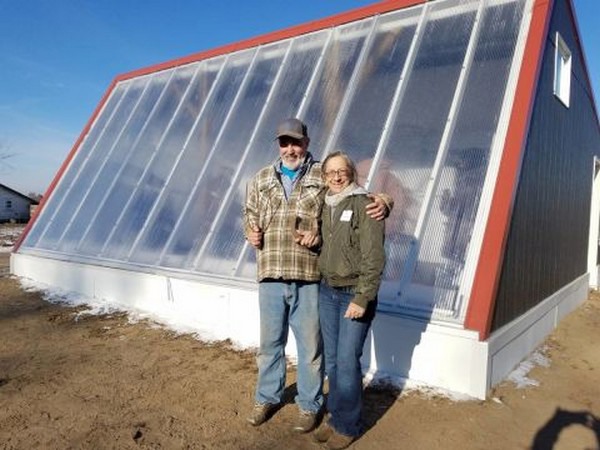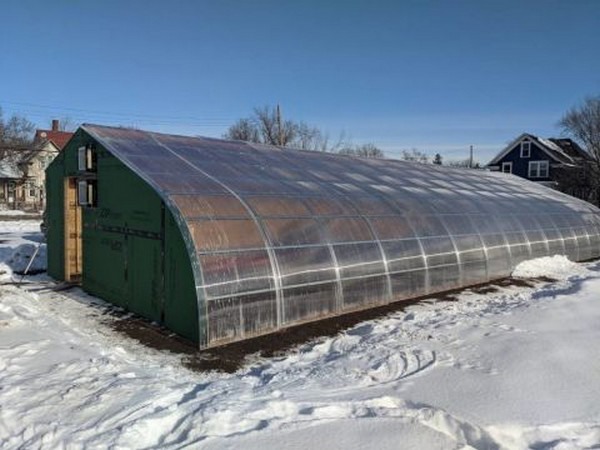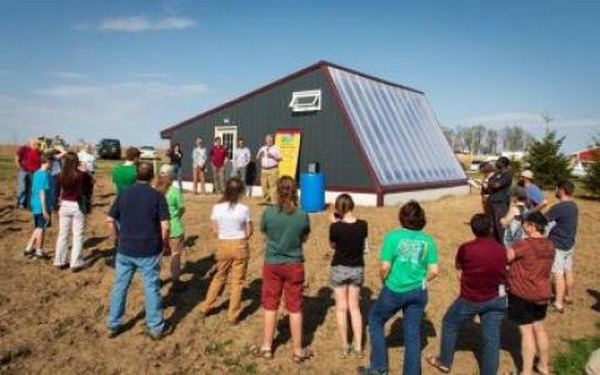Lettuces, Asian greens, herbs and more. These are just a few types of produce that Shayne Johnson of Grampa G’s farm in Pillager has experimented with growing in the middle of winter in Central Minnesota.

Shayne (left) and Louise Johnson of Grampa G’s farm in Pillager, outside their deep winter greenhouse prototype, 2018.
“Nothing we’ve tried to grow has failed,” said Johnson, who sells the farm’s product to local food co-ops and customers in the area by word of mouth.
How does Grampa G’s do it? With the help of a prototype deep winter greenhouse made possible by a collaboration with the University of Minnesota Extension Regional Sustainable Development Partnerships (RSDP) and the College of Design Center for Sustainable Building Research (CSBR).
In fall 2020, this collaboration released new designs for a farm scale winter greenhouse (FSWG v1.0). These new solar winter greenhouse designs seek to improve both the productivity and profitability of extended season vegetable and produce production in Minnesota, creating a more resilient, local food system.
“Our partnerships with Minnesota farmers and the Center for Sustainable Building Research to develop these farm scale winter greenhouse designs will make winter production more accessible to small- and mid-sized farmers in Minnesota and beyond,” said Greg Schweser, statewide co-director of RSDP’s Sustainable Agriculture and Food Systems program who has helped lead related research and outreach with Daniel Handeen, winter greenhouse designer and CSBR research fellow.
Evolution in solar winter greenhouse design
The farm scale winter greenhouse designs rely on passive solar principles, similar to the earlier deep winter greenhouse design (DWG 2.0), but build on and incorporate lessons learned from the deep winter greenhouse prototypes in the field. The deep winter greenhouse at Grampa G’s farm is one of five prototypes in Greater Minnesota, supported by RSDP.

Farm scale winter greenhouse under construction at Appetite for Change in Minneapolis, 2021. Photo credit: Daniel Handeen.
The new farm-scale designs have a larger footprint that increases growing capacity. They also include variations in foundations and thermal storage specifications to accommodate different budgets.
“These designs keep evolving and getting better. That’s what I find so cool about them,” Johnson said. “The University adjusts based on our experiences and feedback with the technology.”
RSDP and CSBR partners iteratively developed the farm-scale winter greenhouse designs with input from growers like Johnson and Carol Ford, Extension project coordinator, and an early winter greenhouse pioneer. Ford has helped spread the word and grow a network of deep winter greenhouse adopters and enthusiasts.
“It’s always been about not just making this technology effective for me, but then having it be something that other farmers would feel engaged to do,” Ford said, during a recent podcast interview about this work.
Since their release in November 2020, the farm scale winter greenhouse designs have had more than 1,150 downloads. Solar winter greenhouse designs are freely available and can be downloaded from the RSDP Deep Winter Greenhouse resource website.
Farm scale designs ripe for testing
Schweser noted the designs are now ripe for testing and recommends a similar, regional prototype approach that proved successful with the earlier deep winter greenhouse design.

Open house at the Lake City Catholic Worker Farm deep winter greenhouse, 2018.
In the earlier prototyping process, university and community partners prioritized both research and education, testing the design’s performance and hosting outreach events that have attracted hundreds of participants.
“It’s turned out to be so much more than just the prototype and initial support,” Johnson said. “It’s now this long-standing relationship. We connect with other greenhouse operators and are regularly in touch with our university partners throughout the year.”
Schweser hopes to see similar results with prototypes of farm-scale winter greenhouses in the coming years. University and community partners could then evaluate their performance in the field and improve existing cost estimates before encouraging more widespread adoption. After field testing, Schweser believes the new structures could open up opportunities for smaller and more diverse farmers to grow more produce and be more profitable.
“The new farm-scale design, more so than the smaller deep winter greenhouses, is far more affordable to construct, and is an appropriate scale for most small direct-market farmers,” Schweser said. “It has the potential to be an equity-building, level-playing field technology to sustainably and profitably grow produce in the winter.”
Johnson is also optimistic about the potential of the new farm-scale winter greenhouse designs. “I love to see the evolution of these greenhouses taking shape,” Johnson said. “We are learning from our accomplishments and defeats, and then we make them better. That’s what’s exciting about this work and these partnerships. If anyone can make these designs better, this initiative is the one to do it.”
For more information:
University of Minnesota Extension
www.umn.com
